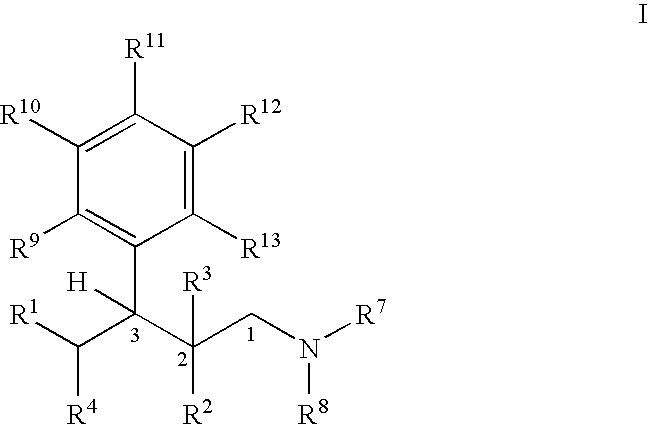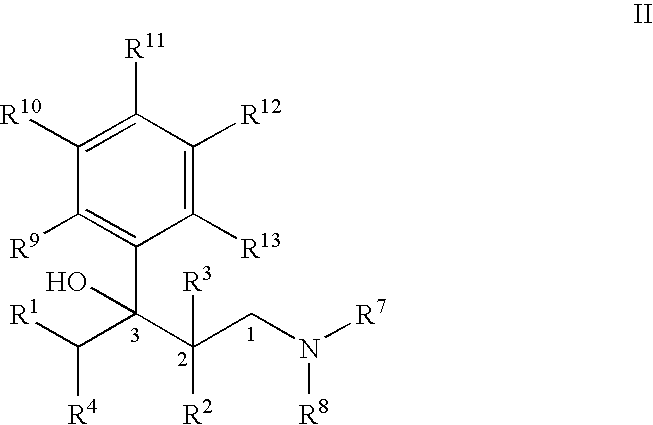Process for the preparation of substituted 3-aryl-butylamine compounds
a technology of arylbutane and aminobutylamine, which is applied in the preparation of amino compounds, organic chemistry, chemistry apparatus and processes, etc., can solve the problems of high excess use, considerable risk of fire and health hazards, and failure to proceed with satisfactory yield
- Summary
- Abstract
- Description
- Claims
- Application Information
AI Technical Summary
Benefits of technology
Problems solved by technology
Method used
Image
Examples
example 1
[0512]15 kg (59.7 mol) (2S,3S)-1-dimethylamino-3-(3-methoxy-phenyl)-2-methyl-pentan-3-ol were initially introduced into a 100 l double-walled reaction unit with an electrical anchor stirrer, Pt100 temperature-measuring device and oil-based cooling / heating system at 20° C. and a stirring speed of 100 rpm, and 26.25 l 36 wt. % (308 mol) aqueous hydrochloric acid were added in the course of 10 min. The reaction mixture was heated to 50° C. in the course of 20 min and stirred at this temperature for 4-6 hours. Thereafter, the mixture was cooled to 25° C. and diluted with 13 l water. Approx. 32 l 32 wt. % (256 mol) sodium hydroxide solution were added at an internal temperature of 20° C., while cooling with a jacket temperature of 5° C., until a pH of 10-12.5 was reached. Thereafter, 22.5 l ethyl acetate were added and, after 10 min under stirring, the stirrer was switched off for the phase separation. The lower aqueous phase was drained off and the upper organic phase was distilled off ...
example 2
[0513]15 kg (52.15 mol) (2S,3S)-1-dimethylamino-3-(3-methoxy-phenyl)-2-methyl-pentan-3-ol hydrochloride were initially introduced into a 100 l double-walled reaction unit with an electrical anchor stirrer, Pt100 temperature-measuring device and oil-based cooling / heating system at 20° C. and a stirring speed of 100 rpm, and 26.25 l 36 wt. % (308 mol) aqueous hydrochloric acid were added in the course of 10 min. The reaction mixture was heated to 50° C. in the course of 20 min and stirred at this temperature for 4-6 hours. Thereafter, the mixture was cooled to 25° C. and diluted with 13 l water. Approx. 32 l 32 wt. % (256 mol) sodium hydroxide solution were added at an internal temperature of 20° C., while cooling with a jacket temperature of 5° C., until a pH of 10-12.5 was reached. Thereafter, 22.5 l ethyl acetate were added and, after 10 min under stirring, the stirrer was switched off for the phase separation. The lower aqueous phase was drained off and the upper organic phase was...
example 3
[0514]15 kg (59.68 mol) of a 70:30 mixture of (2S,3S)-1-dimethylamino-3-(3-methoxy-phenyl)-2-methyl-pentan-3-ol and (2S,3R)-1-dimethylamino-3-(3-methoxy-phenyl)-2-methyl-pentan-3-ol were initially introduced into a 100 l double-walled reaction unit with an electrical anchor stirrer, Pt100 temperature-measuring device and oil-based cooling / heating system at 20° C. and a stirring speed of 100 rpm, and 26.25 l 36 wt. % (307.9 mol) aqueous hydrochloric acid were added in the course of 10 min. The reaction mixture was heated to 50° C. in the course of 20 min and stirred at this temperature for 4-6 hours. Thereafter, the mixture was cooled to 25° C. and diluted with 13 l water. Approx. 32 l 32 wt. % sodium hydroxide solution (256 mol) were added at an internal temperature of 20° C., while cooling with a jacket temperature of 5° C., until a pH of 10-12.5 was reached. Thereafter, 22.5 l ethyl acetate were added and, after 10 min under stirring, the stirrer was switched off for the phase sep...
PUM
| Property | Measurement | Unit |
|---|---|---|
| reaction time | aaaaa | aaaaa |
| reaction time | aaaaa | aaaaa |
| reaction temperature | aaaaa | aaaaa |
Abstract
Description
Claims
Application Information
 Login to View More
Login to View More - R&D
- Intellectual Property
- Life Sciences
- Materials
- Tech Scout
- Unparalleled Data Quality
- Higher Quality Content
- 60% Fewer Hallucinations
Browse by: Latest US Patents, China's latest patents, Technical Efficacy Thesaurus, Application Domain, Technology Topic, Popular Technical Reports.
© 2025 PatSnap. All rights reserved.Legal|Privacy policy|Modern Slavery Act Transparency Statement|Sitemap|About US| Contact US: help@patsnap.com



